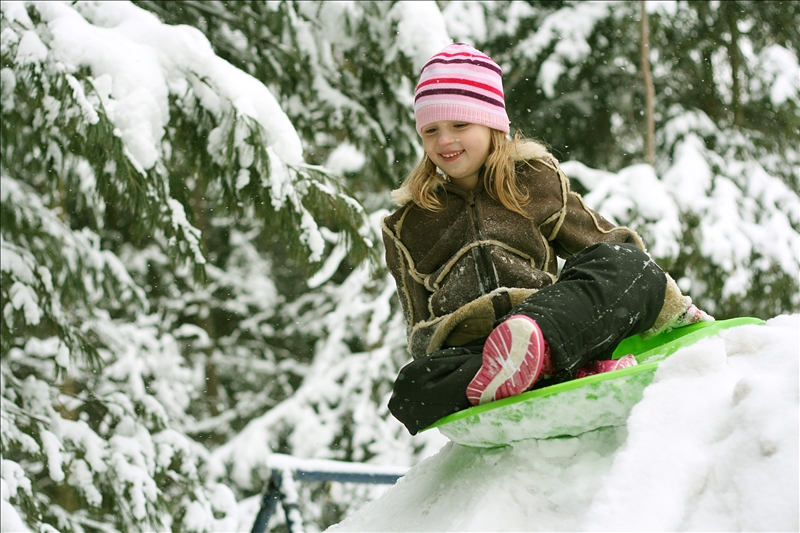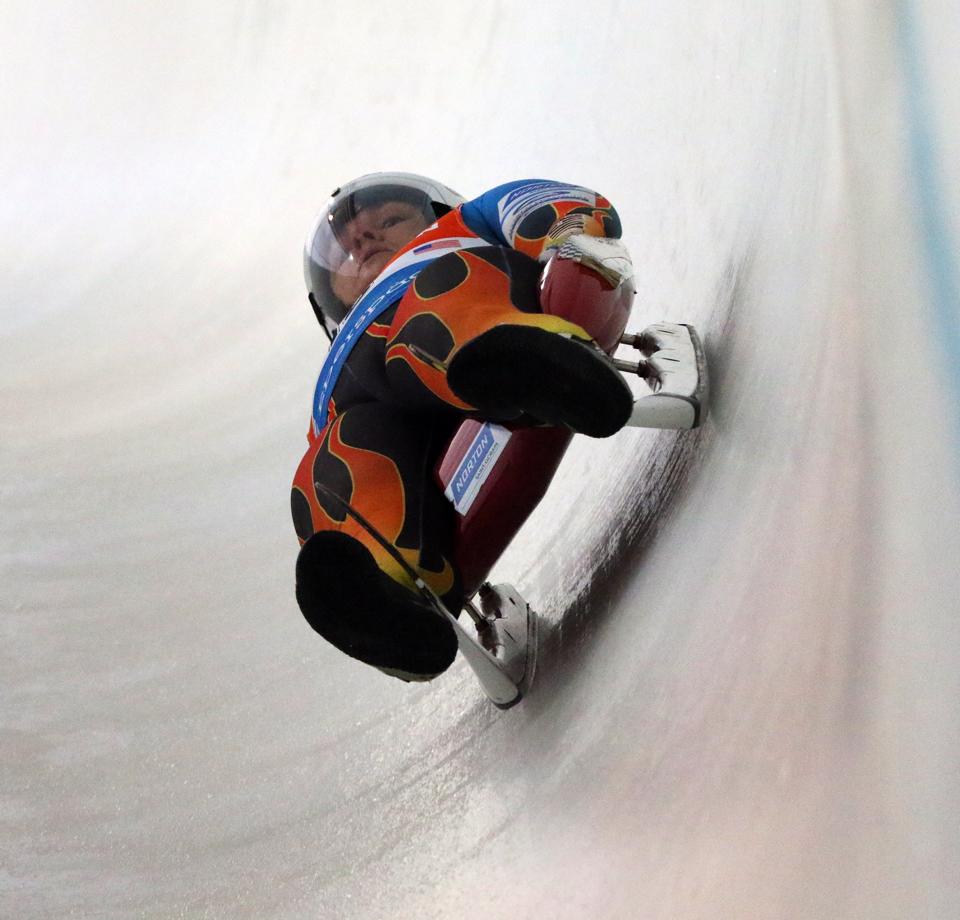Imagine that you have trudged to the top of your favorite sliding hill. You take a deep breath and down you fly — sitting or stretched out on your belly. Your choice.
It’s an exhilarating ride. Straight down, up and over a few bumps along the way.
The view is magnificent. A blanket of fresh snow, a forest of pine trees, wispy clouds in the blue sky.
You pick up speed and still want to go faster and faster. You’re certain you must be going at least 20 mph. Maybe even more.
When you reach the bottom, you scramble to your feet, ready to race down the hill again. And again.
Julia Clukey, who’s from Augusta, loves the thrill of sledding down a hill. Only she does it flat on her back on an aerodynamic sled called a luge. Her view is of her feet and a long, winding, icy and seemingly treacherous track. How fast does she go? About 90 miles an hour! How’s that for exhilarating?
It all began when she was 12 years old. Julia and a friend read in the paper that USA Luge was holding a recruiting event in Portland. They’d never heard of luge before but thought it might be a fun adventure. Along with the chance to ride a luge sled on wheels down Spring Street, they’d also get a free t-shirt.
A few months after the event, Julia was invited to the Lake Placid, NY Olympic Training Center to try the real thing. “I fell in love,” she says. “It was on the 1980 Olympic track in Lake Placid, NY which has since been replaced. It was a wild ride not like any activity I had participated in before. I remember feeling immediately like I had found an activity that I loved — like I was meant to do it.”
Today, 18 years later, Julia is an international luge champion. In 2010, she qualified for the U.S. Olympic team and finished 17th at the Winter Olympics in Vancouver. In 2012, she won two silver medals in World Cup competition and was the 2012 USA Luge Female Athlete of the Year. Currently, she’s a member of the USA Luge national team and races in several national and international competitions.
Set goals. Work hard. No matter what.
None of her successes came easily, Julia recently told middle and high school students at North Yarmouth Academy.
As the spokeswoman for the Maine Beer & Wine Distributors Association’s Responsibility Initiative, she does a lot of speaking to students. (When she’s not streaking down a luge track somewhere in the world.) She accepted the position partly because she believes her story might inspire kids to set big dreams for themselves.
“I want them to feel that they have the potential to do anything they put their minds to,” she says. “It doesn’t matter where they come from or what their background is. If they’re willing to work hard and they find something that they love, they shouldn’t be afraid to go after it.”
Setting goals and working hard — really hard — to achieve them is at the root of Julia’s philosophy on competing (and life in general.) “Setting goals is especially important when things are not going well,” she says.
It’s something she learned the hard way, after some major setbacks that might have put an end to her career if she’d let them.
In 2009, she tore a meniscus during training and had major knee surgery. While she was still on crutches, she competed in the USA Luge Start Championship and won the event.
That same year, she had a herniated disk in her neck. She went on to be diagnosed with Arnold-Chiari malformation, which is a structural defect in the brain. To explain it as simply as possible, there is a large opening in the base of the skull where the spinal cord attaches to the brain. In someone with a Chiari malformation, the part of the brain called the cerebellum slips partway into the spinal column (kind of like a hernia) and prevents spinal fluid from circulating as it should in the brain. It can cause headaches and other neurological symptoms.
In 2011, Julia had successful brain surgery, but it took a year of training and rehab to fully recover and get back to competing. She returned in a blaze of glory, winning her first national title and achieving her personal best, placing 6th in overall World Cup rankings.
In 2014, she missed a spot on the US Olympic team by a heartbreaking 0.013 of a second.
She tells the NYA students that missing a goal can be devastating, but they shouldn’t let one moment of failure define who they are. “Anytime you’re facing a challenge that’s when you’re going to learn about yourself,” she says. “You learn how strong you are as a person. I think it’s important to hear that. There are going to be challenges in your life that you’re going to have to overcome. Making good decisions, being prepared and having a good support system are things you can be doing now so when those tough days come, you’re ready for them and you can find a way to navigate them.”
An inspiration?
Did her story of successes and failures inspire the students? Maybe not all of them says Principal John Drisko, it, but hopefully, some. “It could be one particular line that a student listens to and then walks away and then, later on, thinks about it,” he says. It’s amazing how impactful these
Here’s what some of the students had to say:
“I love playing the flute. That’s my thing. She’s an Olympian which is like a crazy level of talent, but the flute is something I really like doing the same way. I’m still trying to decide between academics and flute but hearing how she balanced both [school and the luge] makes me feel like I could do both things and still succeed to the highest level possible.” Olivia Stam
“She definitely showed me that I want to follow my dream more now. I want to act, do something maybe on Broadway, maybe in Hollywood. I’ve always had a passion for theater and it’s certainly something I want to keep doing.” Rick Hilscher
“I found it very inspiring and motivating — just going after things you haven’t done before and trying things you don’t know. I’ve always been a skier but I’ve never been a competitive skier so I may try that.” Nathanial Lapoint
“I like singing, but I haven’t set any goals. We’ve always heard that working hard pays off but it was nice to see a real live example of it. She showed how hard she works. She had a dream and she set goals for herself and she worked hard and accomplished it.” Avery Bakewell
Find your passion
Yes, you have to set goals and work hard. But first, says Julia, you have to find your passion. “Your story is unfolding right now,” she said to students, “and you have to be willing to try a lot of new things to find something that you are passionate about —to find something that you love to do.”
It’s obvious that Julia found her passion. So, what does she see as she whizzes down the icy track at 90 mph? What does she think about?
“When I am racing,” she responds, “it is actually really easy to zone out on everything around me. Our races are mixed between large crowds and almost no one at the track. I try to keep my mindset the same every time and clear my head and just focus on the task at hand. The feeling varies depending on how the race is going. In my best races, I have a feeling of freedom and complete relaxation on the sled. Any tensions will slow you down in our sport, so being able to find a way to be relaxed and free is important.”
Another lesson to learn from a champion. Relax! Now, try to do that while you watch this video of Julia racing in the World Cup. (Courtesy NBC Sports Network.)
You can learn more about Julia’s career and how she is trying to inspire and motivate kids on her website.





Leave A Comment